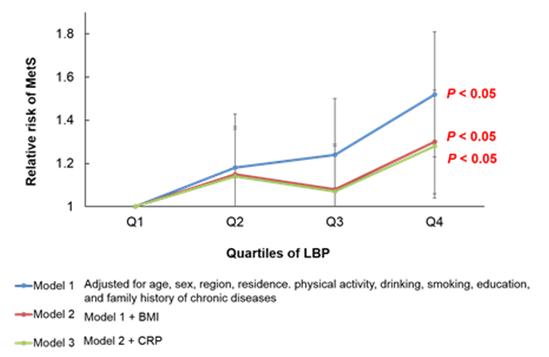
Researchers Discover Positive Association between Plasma Lipopolysaccharide Binding Protein Level and Incidence of Metabolic Syndrome among Middle-aged and Older Chinese
Aug 14, 2014 Email"> PrintText Size

A research team led by Professor LIN Xu at the Institute for Nutritional Sciences, Shanghai Institutes for Biological Sciences reported that elevated plasma lipopolysaccharide binding protein (LBP), a marker of microbiota-derived endotoxemia, was associated with an increased risk of developing metabolic syndrome (MetS) among middle-aged and older Chinese, especially in normal-weight individuals.
In recent years, the role(s) of gut microbiota in the development of chronic metabolic disorders has attracted increasing attention and gram-negative bacteria trigged endotoxemia was proposed to induce low-grade inflammation and related metabolic disorders. However, the evidence from population-based longitudinal studies was scarce.
In this first population-based prospective study, Drs. LIU Xin, LU Ling and SUN Liang from Professor LIN’s group, investigated the association between LBP and 6-year incidence of MetS among 2,529 men and women aged 50-70 years from Beijing and Shanghai. The major findings include: 1) plasma LBP at baseline was significantly associated with body mass index (BMI), waist circumference, blood lipid profile and C-reactive protein (CRP) both at the baseline survey and follow-up survey (all P< 0.05). 2) The relative risk (RR) (95%CI) for incident MetS comparing extreme quartiles of LBP was 1.28 (1.04, 1.58), after multivariate adjustment including BMI and CRP (Fig.1). 3) In stratified analysis, LBP was positively associated with incident MetS only in normal-weight participants (RR [95%CI] across extreme tertiles = 1.59 [1.18, 2.15]; P for trend = 0.002), but not in their overweight/obese counterparts (RR [95%CI] comparing extreme tertiles = 0.99 [0.80, 1.22]; P for trend = 0.880). A significant interaction was observed between LBP and obesity status (P for interaction = 0.013).
The findings have highlighted the critical role of subclinical endotoxemia, represented by elevated circulating LBP, in the future development of metabolic deteriorations in normal-weight participants.
This study, entitled “Lipopolysaccharide binding protein, obesity status and incidence of metabolic syndrome: a prospective study among middle-aged and older Chinese”, was published in Diabetologia on June 8, 2014. It was supported by the Ministry of Science and Technology of China, National Natural Science Foundation of China and the Knowledge Innovation Program of Shanghai Institutes for Biological Sciences, Chinese Academy of Sciences, etc.

Fig.1 Association between LBP and the incidence of metabolic syndrome. (Image by LIN Xu's group)
CONTACT:
LIN Xu, Principle Investigator
Institute for Nutritional Sciences, Shanghai Institutes for Biological Sciences, Chinese Academy of Sciences,
Shanghai 200031, China.
Tel: 86-21-54920249
Fax: 86-21-54920291
Email: xlin@sibs.ac.cn
A research team led by Professor LIN Xu at the Institute for Nutritional Sciences, Shanghai Institutes for Biological Sciences reported that elevated plasma lipopolysaccharide binding protein (LBP), a marker of microbiota-derived endotoxemia, was associated with an increased risk of developing metabolic syndrome (MetS) among middle-aged and older Chinese, especially in normal-weight individuals.
In recent years, the role(s) of gut microbiota in the development of chronic metabolic disorders has attracted increasing attention and gram-negative bacteria trigged endotoxemia was proposed to induce low-grade inflammation and related metabolic disorders. However, the evidence from population-based longitudinal studies was scarce.
In this first population-based prospective study, Drs. LIU Xin, LU Ling and SUN Liang from Professor LIN’s group, investigated the association between LBP and 6-year incidence of MetS among 2,529 men and women aged 50-70 years from Beijing and Shanghai. The major findings include: 1) plasma LBP at baseline was significantly associated with body mass index (BMI), waist circumference, blood lipid profile and C-reactive protein (CRP) both at the baseline survey and follow-up survey (all P< 0.05). 2) The relative risk (RR) (95%CI) for incident MetS comparing extreme quartiles of LBP was 1.28 (1.04, 1.58), after multivariate adjustment including BMI and CRP (Fig.1). 3) In stratified analysis, LBP was positively associated with incident MetS only in normal-weight participants (RR [95%CI] across extreme tertiles = 1.59 [1.18, 2.15]; P for trend = 0.002), but not in their overweight/obese counterparts (RR [95%CI] comparing extreme tertiles = 0.99 [0.80, 1.22]; P for trend = 0.880). A significant interaction was observed between LBP and obesity status (P for interaction = 0.013).
The findings have highlighted the critical role of subclinical endotoxemia, represented by elevated circulating LBP, in the future development of metabolic deteriorations in normal-weight participants.
This study, entitled “Lipopolysaccharide binding protein, obesity status and incidence of metabolic syndrome: a prospective study among middle-aged and older Chinese”, was published in Diabetologia on June 8, 2014. It was supported by the Ministry of Science and Technology of China, National Natural Science Foundation of China and the Knowledge Innovation Program of Shanghai Institutes for Biological Sciences, Chinese Academy of Sciences, etc.

Fig.1 Association between LBP and the incidence of metabolic syndrome. (Image by LIN Xu's group)
CONTACT:
LIN Xu, Principle Investigator
Institute for Nutritional Sciences, Shanghai Institutes for Biological Sciences, Chinese Academy of Sciences,
Shanghai 200031, China.
Tel: 86-21-54920249
Fax: 86-21-54920291
Email: xlin@sibs.ac.cn
CAS Institutes
There are 124 Institutions directly under the CAS by the end of 2012, with 104 research institutes, five universities & supporting organizations, 12 management organizations that consist of the headquarters and branches, and three other units. Moreover, there are 25 legal entities affiliated and 22 CAS invested holding enterprisesThere are 124 I...>> more
Contact Us

Chinese Academy of Sciences
Add: 52 Sanlihe Rd., Xicheng District, Beijing, China
Postcode: 100864
Tel: 86-10-68597592 (day) 86-10-68597289 (night)
Fax: 86-10-68511095 (day) 86-10-68512458 (night)
E-mail: cas_en@cas.cn

